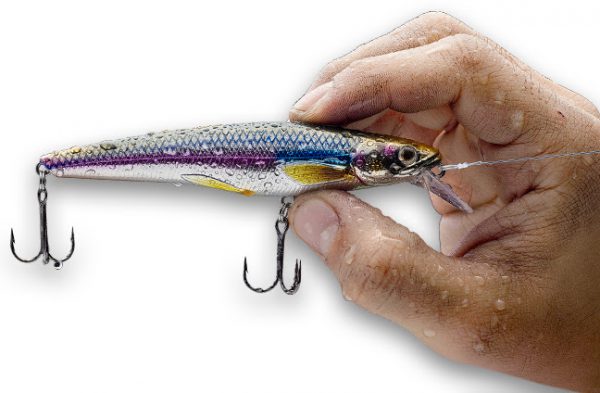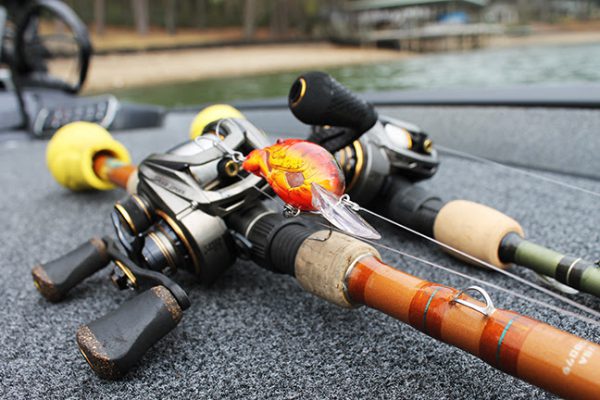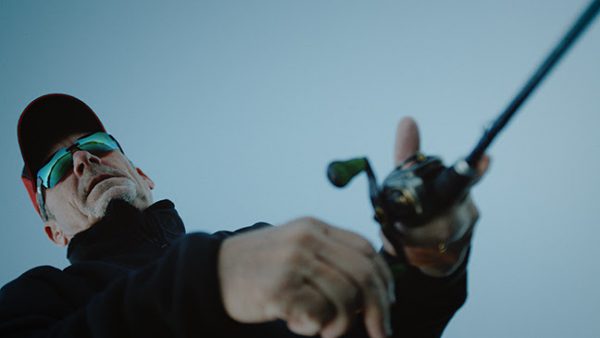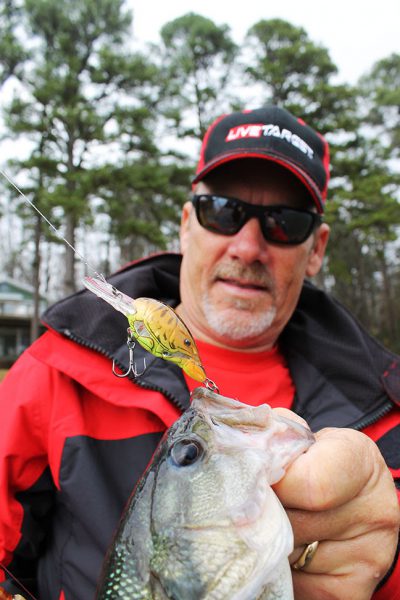Late-Season Bass: Search and Destroy
Category: article
Oct 15th, 2019 by Keith Worrall
Modified Oct 15th, 2019 at 11:44 AM
Late-Season Bass: Search and Destroy
LIVETARGET bass pro Stephen Browning discusses surefire ways to locate and catch more fall and early winter bass
Niagara-on-the-Lake, ON (October 14, 2019) – Fall weather can spread bass out in many waterways, making for difficult bites. Given a refined approach, however, fall can provide some of the best fishing of year – especially for big bass.
Noted professional angler Stephen Browning, a seasoned veteran of the FLW Tour, MLF, and the Bassmaster Elite Series, has amassed knowledge of late-season bass behavior that can up any angler’s game right now. Aside from decades of experience on tournament trails, Browning’s degree in Fish and Wildlife Management hasn’t hurt his ability to pick apart various waters, either.
The first tip? Cover lots water. And for Browning, that means crankbaits.
“For me, fall is all about chunk and winding and covering water, whether that’s main lake stuff or hitting the back of pockets, coves, and creeks. Crankbaits are definitely key in fall and into early winter,” says Browning.
For Browning, the biggest factor for finding fall bass to crank is water temperature. “I’m trying to search out water temperatures that are 70 degrees or less, because experience proves that’s the point at which fish get fired up for a super fall bite.”
Winning in the Wind
Secondly, he’s monitoring wind. “Besides cooler water, I’m looking for spots where the wind is blowing a little bit. There’s still a lot of fish out on the main lake and not necessarily deep into the pockets. So, I’m going to look at the wind—see where it’s hitting the banks the best. Bass will utilize the wind to kind of break things up. You can burn down a pea gravel bank or a chunk rock bank and still have the ability to catch fish. And they aren’t always target oriented. In my opinion, they don’t like to hold tight to cover when the wind’s blowing, because it’s going to beat them around. So, I think they do more roaming in the wind—if it’s windy I’m going to chunk and wind,” says Browning.

For such windy scenarios and main lake fishing, Browning turns to the LIVETARGET Rainbow Smelt suspending jerkbait—specifically the RS91S, which is 3-5/8 inches long and dives three to four feet, typically in the (201) Silver/Blue pattern, although Browning has been experimenting with the host of new colors LIVETARGET now offers in this highly effective bait.
“It’s kind of a shallower-diving jerkbait, which I utilize for cranking points, rock outcrops, rip-rap, etc. when the wind is blowing. When fishing it, I’m looking for a little bit of visibility… not a lot of stain. I fish it a lot in main lake and main creek areas using the wind and water clarity as kind of a one-two punch. It’s definitely a go-to bait for these situations,” offers Browning.
Browning throws the LIVETARGET Rainbow Smelt on a 6’8” medium-heavy St. Croix Legend X casting rod, Lew’s 7.5:1 Pro TI baitcasting reel, and 10-pound Gamma fluorocarbon.

Another bait Browning utilizes for windy main lake and main creek scenarios is the LIVETARGET HFC (Hunt-For-Center) Craw. “It has a very aggressive action and deflects off of cover, so I can utilize it on steeper rocky banks and really cover a lot of water. In terms of color, it depends on the water clarity and temperature. If the water is stained, a lot of times I’ll use LIVETARGET’s Red (362) or Copper Root Beer (361). The latter has a really nice copper hue to it and kind of a whitish-style belly.
When the water temperature plummets into the 50s, Browning also reaches for the LIVETARGET HFC (Hunt-For-Center) Craw, especially in the Red (362) and Copper Root Beer (361) colors. “The HFC has an aggressive action but is not overpowering. It was designed to randomly dart left and right, mimicking a fleeing craw. In late fall when the water gets really cold it can be a fantastic bait for target fishing for the resident fish that live in the very back ends of creeks and pockets.”

Water Clarity and Target Cranking
Browning’s advice for those days when there isn’t much wind is to monitor water clarity. “On calmer days water clarity is a big factor. I’m going to go and try to find some stained water someplace within the fishery. The biggest thing about stained water is fish don’t tend to roam as much on you, and they’re going to be more target related—an outcrop of rocks, a laydown, a series of stumps, etc. that will give those fish a place to ambush their prey.”
On those calmer days, Browning will vacate the main lake and main creek areas he fishes when windy and concentrate on the back third of pockets where they have a tendency to flatten out. There, he looks for isolated cover.

LIVETARGET David Walker Signature Tennessee Craw
“I’m looking for that isolated stump, maybe a log, lay-downs, isolated grass patches, or a lot of times people will put out crappie stakes. Especially when the water’s low, bass will utilize crappie stakes. One of the baits I like for target fishing in the back of pockets is the LIVETARGET David Walker Signature Tennessee Craw. I’ll crank it on 12- or 14-pound fluorocarbon and only get it down to six feet so I can bang it around, which is key to getting good target bites. I’ll make multiple casts to the isolated cover from various angles giving the fish the most opportunities to ambush my presentation. That’s really key—working cover from multiple angles and making sure you spend ample time on each spot,” offers Browning.

When target fishing, Browning is also a fan of the shallow-diving LIVETARGET Sunfish Crankbait—specifically the BG57M (bluegill pattern) and PS57M (pumpkinseed pattern). “The Sunfish Crankbait has a rounded bill, so it has a nice, tight wiggle to it. For me, especially when the water temperature gets cooler, it becomes another go-to bait for target fishing. I think it kind of gets overlooked by anglers who tend to concentrate on shad patterns, but bluegills are a major forage source in fall and year ‘round that bass will really home in on.”
Water clarity dictates whether Browning will choose the Pumpkinseed or Bluegill pattern, as well as the choice between LIVETARGET’s available matte and gloss finishes. “I use the Bluegill if the water is a bit clearer and the brighter Pumpkinseed in stained water. I like using the gloss finish if the sky is cloudy and the matte finish if it’s sunny. So, you’ve got two different colors and two different finishes for a variety of fishing situations.”

In terms of equipment for cranking the LIVETARGET HFC (Hunt-For-Center) Craw, David Walker Tennessee Craw, or Sunfish Crankbait, he sticks to the same set-up of a St. Croix 7’4” medium-heavy, moderate action Legend Glass rod, a Lew’s Custom Pro baitcasting reel with 8:1 gear ratio and either 12- or 14-pound Gamma Fluorocarbon line. “If I’m concentrating on shallow areas, I’m going to use the heavier line – but if I need the bait to get down six feet or more, I’m going to use the 12-pound line,” Browning adds.
Topwaters Too
When targeting the backs of pockets and creeks with grass, Browning urges anglers not to overlook the efficacy of employing a chunk-and-wind topwater routine.
“The LIVETARGET Commotion Shad is a hollow-body shad style topwater bait that has a Colorado blade on the back end. It’s a real player in the kind of broken-up grass you find way back in pocket flats. During the fall, adding this bait to the chunk-and-wind crankbait program can really pay off. It comes in a couple of sizes, but I like the 3-½ inch in Pearl Ghost (154) and Pearl Blue Shad (158). The spinner makes a gurgling sound when you retrieve it like you would a hollow body frog, and it’s great for working over grassy areas,” offers Browning.

For gear, Browning throws the Commotion Shad on a 7’6” medium-heavy, moderate action St. Croix Legend X with a Lew’s Tournament reel geared 8.3:1, and 50-pound Gamma Torque braided line.
Parting Advice
While monitoring water temperature, wind conditions, water clarity, and the amount of visible sunlight are all huge factors for finding fall bass in main lakes and creeks as well as pockets and coves, Browning suggests anglers stay tuned to another of nature’s cues: bird behavior.
“Watch for the migration of shad, which have the tendency to move to the very back ends of the pockets in fall, but also know, as mentioned, that bass are feeding on bluegills and craws in lots of other locations. You can really eliminate a lot of water and fish more productively by keying in on bird behavior. They’re going to tell you where the baitfish are. Could be a Blue Heron sitting on the bank eating bluegills or picking around on crawfish, gulls, or all sorts of other birds either on the main lake or back farther in coves. Really pay attention to where the birds are. It’s definitely one of the small details that gets overlooked by a lot of anglers.”
